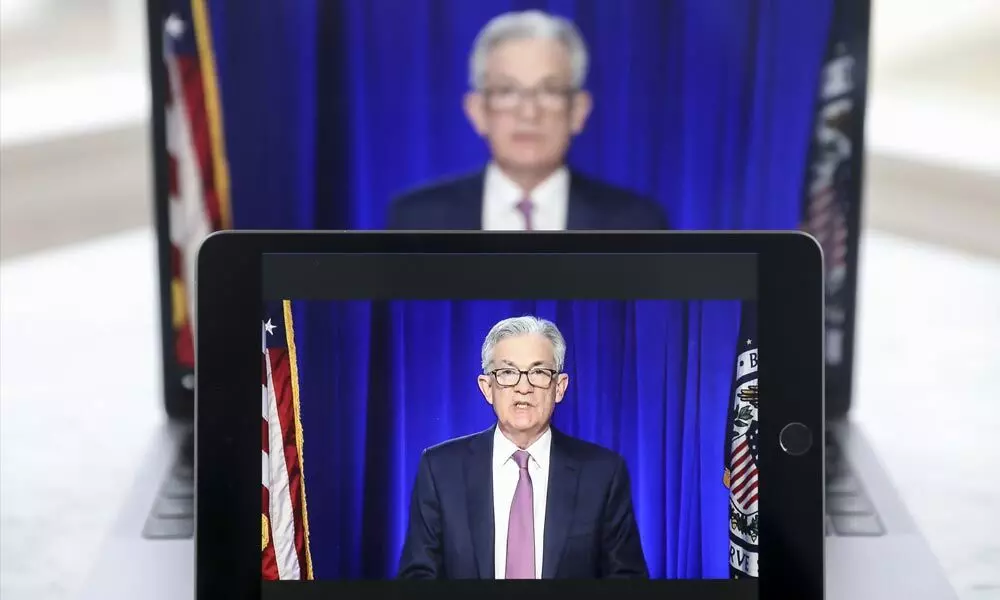The dovish Fed should embrace mkt optimism
The Fed should be every bit as optimistic about growth as the market has been, while still sticking to its script on the timing of any rate increase. Only by meeting or exceeding the optimism of investors while retaining its current policy stance can Powell persuade investors that he’s determined to let the economy run hot in order to achieve the Fed’s objectives
image for illustrative purpose

The challenge will be pushing back market expectations that an interest rate increase could come as soon as the end of next year
The Federal Reserve's monetary policy meeting this week is a chance for the central bank to get back on the same page with the bond market. The challenge will be pushing back market expectations that an interest rate increase could come as soon as the end of next year. How it delivers that message convincingly will be key.
Chair Jerome Powell's language in recent speeches has stressed that the factors needed to justify raising rates will be much different than in the past. The new framework is about waiting for economic outcomes to be achieved before increasing rates, rather than relying on models that haven't done a good job of correctly forecasting inflation in recent decades. Even if policy makers ultimately end up raising rates in 2023, they're unlikely to hint at that possibility this week.
The best way for the Fed to show commitment to its new framework is in the Summary of Economic Projections it will release along with its policy statement on Wednesday. A cautious outlook that emphasises the risks and uncertainties surrounding economic reopening wouldn't be surprising.
But instead, the Fed should be every bit as optimistic about growth as the market has been, while still sticking to its script on the timing of any rate increase. Only by meeting or exceeding the optimism of investors while retaining its current policy stance can Powell persuade investors that he's determined to let the economy run hot in order to achieve the Fed's objectives.
The rise in the 10-year Treasury yield - around 0.7 percentage point since the central bank last produced projections at its December meeting - makes sense given all that's happened since then. Congress passed two rounds of fiscal relief - $900 billion on December 27th, and the $1.9 trillion American Rescue Plan that President Joe Biden signed into law last week. Covid-19 infections, hospitalizations and deaths have fallen substantially since mid-January, and more than two million doses of vaccines a day are being administered in the US.
The issue for the central bank and for markets is how what started as a rise in longer-term interest rates has spread into shorter-term interest rates, with the 3-year Treasury rate rising 0.15 percentage point between Feb. 10th and March 12. That might not sound like a lot, but it implies that the market expects interest rate increases could be coming much sooner than the Fed has let on. Its December Summary of Economic Projections forecast zero rate hikes by the end of 2023, but futures markets tied to short-term interest rates have now priced in multiple increases in 2023 and growing odds for one in 2022.
A big reason investors are willing to fight the Fed is that Wall Street has become much more optimistic on economic growth than the Fed's most recent forecast, which saw real Gross Domestic Product growth of 4.2 per cent for the US in 2021. Goldman Sachs Group Inc.'s latest forecast of 8 per cent is almost double that, and many other Wall Street banks have boosted their outlooks to between 5 per cent and 7 per cent.
In the context of the Fed's continued cautious language and dovish policy stance, investors who believe the central bank's growth outlook is too conservative may also assume that when policy makers eventually come around to the market's more optimistic view, they will pull forward the timing of raising interest rates.
The Fed could counteract that thinking by putting out a more optimistic growth forecast - say 2021 US real GDP growth of 7 per cent - while maintaining its dovish policy stance. That would signal its agreement with the market's optimism while not budging from the rate guidance it's been communicating to the public.
As the Fed has consistently said - despite the market's continued struggle with the idea - the bar to increase interest rates is much higher than it was in the 2010's. The goal now is maximum employment, which takes into consideration a range of indicators not captured by the headline unemployment rate, including the racial unemployment gap.
Achieving that alone wouldn't be enough to increase interest rates. Policy makers would also need to see inflation rise above its 2 per cent target with an expectation that it would remain at that level or higher. Even then, before increasing rates the Fed would first need to wind down its asset purchase programme, which it's indicated it has no plans to do any time soon.
The central bank has not yet shown any willingness to push back on the increase in longer-term interest rates, perhaps welcoming how those higher rates have cooled off some of the rise in speculative technology stocks without tightening overall financial conditions. But there's no guarantee that will continue, particularly if investors believe the Fed is giving tacit approval to investors pricing in rate hikes in 2022 and 2023.
To avoid that scenario, the Fed should communicate clearly that even though it shares the market's optimism about growth, that strong growth alone isn't enough for it to begin raising rates again anytime soon.

